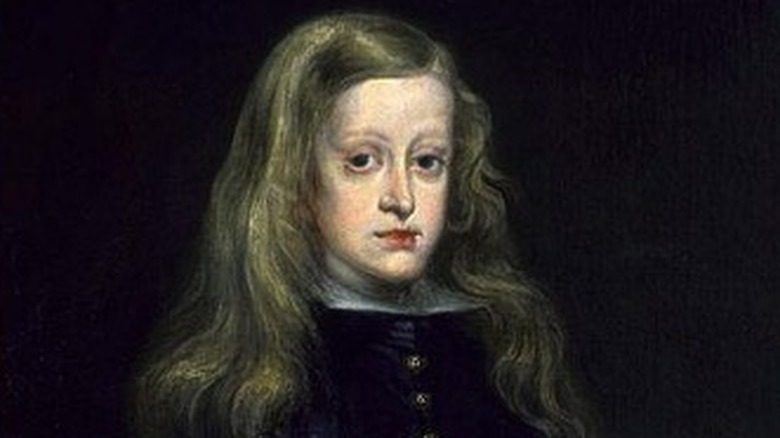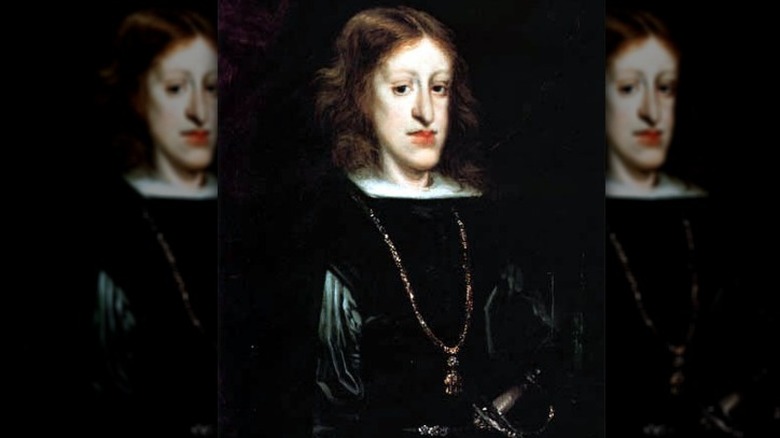Details Found In Charles II Of Spain's Autopsy Report
The two-century reign of the powerful Habsburg family in the Spanish monarchy came to an end in the year 1700 when King Charles II died without an heir, according to an article from Public Library of Science, posted at Science Daily. While they were in power, the Habsburg line, with a royal legacy stretching all the way back to 13th-century Germany and Austria, saw Spain enter the world stage as a colonial empire. While he was alive, King Charles II was known for a distinctive protruding lower jaw, a shared trait among many members of the Habsburg family. Family members were known as well for having unusually large noses and oversized lips, all of which became more pronounced over successive Habsburg generations.
When Charles II died at the age of 39 (via Britannica), details revealed in his autopsy, with notes describing what attending physicians found at the time, have now helped modern scientists theorize what might have been the root cause of the so-called "Habsburg jaw" or "Habsburg chin," as it is sometimes called, a trait apparent both in Charles and elsewhere in the Habsburg family. Recent research also offers insight into why Charles was described as "bewitched" during his lifetime (via Smithsonian Magazine). Perhaps most importantly, though, King Charles II's autopsy may help finally explain why the last royal Habsburg of Spain was never able to produce an heir.
Charles II's autopsy report is unusual
On the surface, the notes from doctors who performed the autopsy on Charles II sound completely made up, relating conditions that were at the very least improbable, if not actually impossible. The notes read that Charles had (via Scielo) "a very small heart of the size of a grain of pepper, the lungs corroded, the intestines putrefactive and gangrenous, in the kidney three large stones, a single testicle as black as coal and his head full of water." Sadly, Charles II had a difficult childhood, with many physical development delays and other challenges. He walked at age 6, breastfed until the age of 4, and lived through many viral and bacterial infections all throughout his young life, among other illnesses. Given the state of medicine at the time, at birth, his gender could not be firmly established. By age 10, Charles spoke only haltingly and could neither read nor write.
For these reasons, those in the Spanish Court at the time called Charles "bewitched," and because of this, the first decade of King Charles II's reigns was a regency under the Queen Mother, as she handled affairs of state. Could all this be related to what doctors found inside his body after he died? For centuries, scientists have pondered whether those striking words written at the time of Charles' autopsy were true, and if true, what conditions they might have described. There's also long been speculation about what may have caused the unusual appearance of Habsburg family members, as well as the many physical challenges and mental delays Charles experienced throughout his life. That research has now produced some answers.
Interbreeding was common in the Habsburg family
Scientists at the University of Santiago de Compostela in Spain have now revealed genetic proof of what historians had long suspected. Based on reporting from Science Daily, The Habsburgs, with royal family in courts all across Europe, were known to interbreed, common in royal families of the era who, in their view, wished to maintain a pure royal bloodline so as to hang on to power. After centuries of inbreeding, though, physical and mental delays are known to crop up, such as they did with Charles, and infant mortality rates also skyrocket, as they are known to have done in the Habsburg family. Over successive generations, the distinctive facial features caused by inbreeding also become more pronounced, much like they did in the Habsburg family.
Further emerging data related to Charles II now also reveals he likely presented as what modern society would call intersex, or of indeterminate gender. Perhaps causing this in Charles II is what's now called Klinefelter's syndrome, a rare chromosomal condition found in males that affects typical testicle development, among many other issues experienced all throughout life, including infertility, as WebMD notes. Also perhaps explaining what doctors described in his autopsy were several congenital kidney issues, also likely the byproduct of inbreeding, and the water described in his brain could have been caused by hydrocephalus, caused by a number of childhood infections Charles is known to have lived through, with symptoms including fluid buildup in the brain, just as his autopsy reports, per Karger.


